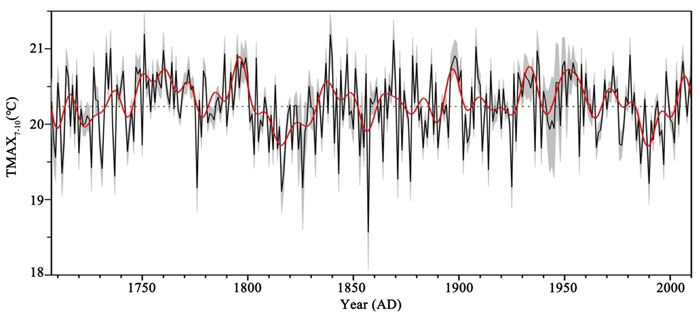| Tweet | Follow @co2science |
Paper Reviewed
Li, M., Huang, L., Yin, Z.-Y. and Shao, X. 2017. Temperature reconstruction and volcanic eruption signal from tree-ring width and maximum latewood density over the past 304 years in the southeastern Tibetan Plateau. International Journal of Biometeorology 61: 2021-2032.
The four Chinese scientists -- Li et al. (2017) -- write that "reconstruction of past climate and investigation of the impacts of climate forcing factors are critical for understanding past and future climate change." And, thus, it was their objective to develop a proxy temperature record for the data-sparse region of the southeastern Tibetan Plateau.
Utilizing 25 cores from 18 trees, Li et al. derived a July-October maximum temperature chronology for this region of the Yunnan Province of southwestern China, covering the years 1707-2010, the ensuing record of which is depicted in the figure below.
In discussing the characteristics of their three-century temperature proxy, the authors report the existence of two prominent decadal-scale cold periods (1801-1833 and 1961-2003) and two prominent decadal-scale warm periods (1730-1800 and 1928-1960). They also note that "fifteen extreme cold years (< -1.5σ) were identified and most occurred within 1-2 years after major volcanic eruptions," contrasting with the finding that the two decadal-scale warm periods both occurred during "gaps in volcanic activities."
Perhaps the most significant observation made by the authors, however, is that "none of the extreme warm years [< 1.5σ] or decades occurred in the most recent 30 years," which fact runs counter to anthropogenic global warming claims that temperatures of the past few decades have been the warmest of the past thousand years. Quite to the contrary, the decade of the 1990s was "the third coldest decade in the past 300 years" and there were multiple times in the three-century record when temperatures reached heights that were warmer than the present. All of these observations suggest that climate alarmists may want to tone down their claims of recent unprecedented warming due to rising atmospheric CO2 concentrations, for such a correlation does not exist in this record.

Figure 1. Reconstructed July-October maximum temperatures (black thin line) and 11-year smoothing (FFT filter) (red thick line) for the southeastern Tibetan Plateau for the period AD 1707 to 2010. The gray area denotes the confidence interval at 95%. Source: Li et al. (2017).




